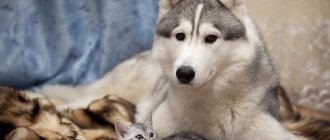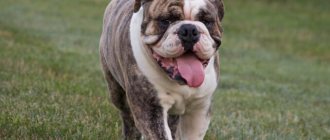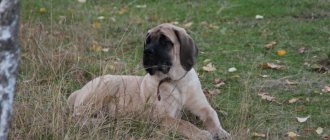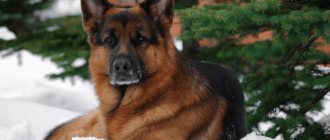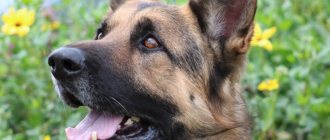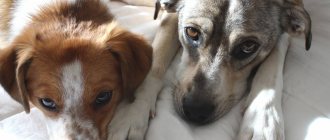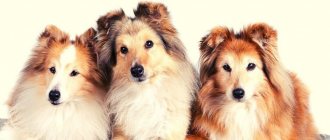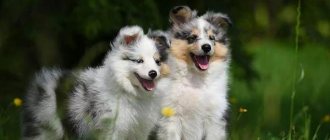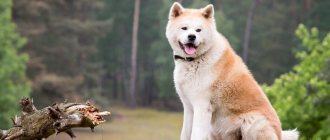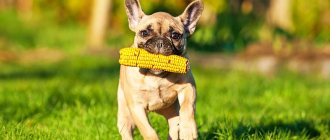Review author: “ZooVita”
The Alaskan Malamute has a plush appearance that hides a strong character. Over hundreds of years of survival in the difficult conditions of a cold country, dogs have acquired independence and developed the intelligence and memory given by nature, so inexperienced owners should think about purchasing another breed.
Description and features
It is believed that the first owners of the Alaskan Malamute dog were Eskimos. A long study of this issue led to a precise definition of the tribes that tamed the animals - the Malmuts. They lived many centuries ago in Alaska.
Outwardly, the dog gives the impression of being powerful, resilient and even dangerous. Yes, he is strong and majestic, but he is not at all aggressive, and therefore does not pose a threat. Thanks to its thick fur and undercoat, it does not freeze at all, even in extreme cold.
Interesting fact! Representatives of this breed actually descended from wolves. People probably crossed forest predators with large huskies. But, Malamutes are absolutely tame, not prone to aggression, like their closest relatives.
The physical parameters of these dogs are excellent. They can carry heavy loads even over very long distances. That is why they have always been exploited by the inhabitants of the Arctic as riders. They are genetically adapted to heavy physical labor.
But it is not advisable to have such a dog solely as a working dog. She is a good and faithful companion who will never leave her beloved owner, but will take care of him as long as he needs consolation. He loves active recreation, especially sports games, such as frisbee.
If you want to have such a pet, you must understand that a quiet lifestyle is not for him. He prefers to move most of the day rather than sleep or rest. Loves long walks, running, jumping, etc.
Constantly being at home makes such a dog unhappy. He enjoys being outdoors and interacting with his fellow creatures. Malamute is a pack dog, so it clearly understands that in any social system there is a hierarchy. This makes it easy to operate. The dog is well trained, as it tends to trust and respect people.
Very kind and welcoming. It extremely rarely barks at strangers who come into the house. Strives to please everyone. For him, guests are potential toys with whom he can have fun. None of them will bite or offend.
Malamute is a very friendly and strong dog
As a bodyguard and watchman, he is not effective. Observation and caution are character qualities that are absolutely not characteristic of huskies. But they have other advantages - mercy, responsiveness, friendliness, playfulness, good motivation to learn, etc.
Breed standard
The Alaskan Malamute breed is large. An adult male grows up to 64 cm, and a female – up to 58 cm. The animal weighs from 34 to 38-40 kg. Errors are undesirable. The dog has a very strong physique and a powerful skeleton. The chest is deep.
The body is rectangular, slightly elongated. The loin is weakly expressed, but the withers are clearly visible. There are dense skin folds in the neck area. Wide paw set. The hind thighs are more powerful than the front ones. The stomach is not sunken. The tail is set high and lies in a “ring” on the back.
A wide, large head looks harmonious against the background of a strong body. The muzzle is slightly pointed, extended forward. At the tip there is a large nose. Her cheekbones and cheeks stand out well. The teeth are very sharp, especially the fangs. They have a bright white color.
The ears are in the shape of a triangle, set symmetrically. According to the standard, they cannot be recumbent. Such a defect in an individual is a reason for its culling. The dog's lips should be pressed firmly against the gums. There should be no saliva dripping from his closed mouth.
The Alaskan Malamute in the photo is a smart and very kind dog. This external image is largely deserved by him due to the presence of large slanting eyes. According to the standard, their iris should be brown. If you see an individual with blue eyes, then you know that she is of low breed.
Representatives of the breed have a very hard coat, while the undercoat is soft. This is a natural necessity. Their fur is covered with moist fat, which performs a waterproof function. Most often, the body of Malamutes is covered with silver-white hair (there is a “mask” on the face). It is less common to find an individual with red spots.
Main breeding lines
Malamutes are divided into 2 main types - M'Lut and Kotzebue. Representatives of these breeding lines have some differences in appearance, which relate mainly to the color of the coat and the size of the adult individual.
Kotzebue
These are friendly, strongly built dogs with a dense and long coat of gray (wolf) color. They are characterized by the presence of a kind of mask on the face and head.
This breed began to be bred in the USA (in New England), by crossing Labrador Huskies, Greenland and Eskimo dogs and, of course, Alaskan Malamutes. As a result of such selection work, unique dogs were bred, which, unfortunately, remained in the shadows for quite a long time and were considered only one of the varieties of the so-called “Eskimo dogs.”
These dogs were recognized as a separate breed only in 1935 by the American Kennel Club (AKC).
M'Loot
Malamutes of this line have larger dimensions (the average height of an adult dog at the withers is 63 cm, weight is 38 kg), they are characterized by aggression, and the coat of these dogs can be blue, white, white-black, white-brown, sable or white. - red color.
Almost simultaneously with the selection of Kotzebue, a dog breeder from New Hampshire began developing a new breed, crossing dogs from Minnesota, Montana, Alaska and 2 female white Canadian Eskimo dogs. Due to the variety of breeds that were selected for breeding work, the Malamutes of the M'Lut line turned out to be very diverse and their coat has many color variations.
Representatives of this line were not registered at the 1st free registration, since the person who bred the breed was not interested in its registration and participation in exhibitions.
Kinds
Breeders standardized 2 types of breed - Kotzebue and M-lut. Each of them has a number of distinctive features. For example, the first one is less powerful and hardy. But such dogs are much kinder, and they also have well-developed sociable abilities. If we talk about m-loot, it is worth noting that this dog is capable of aggression. It is larger, has amazing endurance and strength.
Modern breeders often argue as to which of these types of Malamute is more correct. Most families prefer the Kotzebue, considering it a good, big guy. But there are husky lovers who need to protect their territory. M-loot is more suitable for them.
Owner reviews
According to reviews from the owners, if you work with a puppy of this breed constantly from the very beginning, then in the future such a dog will be a faithful, obedient friend who recognizes the leadership of its owner and shows practically no stubbornness.
However, if there are kids in the house, then it is better to hold off on purchasing a Malamute and wait until the children are older.
Alaskan Malamute - all about the dog breed: video
Malamutes are one of the oldest dogs, distinguished by a high degree of endurance and excellent working qualities.
Possessing quite large sizes, representatives of this breed are not at all aggressive and, no matter how much effort the owner puts into it, they are absolutely not suitable for the role of guards.
In this article we will look at what types of Malamutes exist in the world and what each of them looks like.
Character
The kindness of Malamutes is limitless. These dogs love people very much, they quickly become attached to them, finding an approach to everyone. The idea that likes are capricious is wrong. They are loyal, friendly and responsible, so they make good contact with any person.
A representative of the breed expects similar qualities from people. He likes to be the center of attention, but not when alone. He prefers to surround himself with noisy people who are not averse to playing and having fun.
He likes active rather than passive recreation. When going outdoors together, be prepared for the fact that your pet will not leave you alone. He will start rushing around people, jumping, making loud noises, calling them to play.
Representatives of the breed get along especially well with children. They are naturally responsible, so they can serve as house nannies. They will never leave the baby alone if there are no adults nearby. They carefully watch him so that he doesn’t get into trouble.
They can enter into a fight with a stronger opponent who threatens the peace of their family. From its closest ancestor, the wolf, the Alaskan Malamute inherited courage, courage and fearlessness.
Malamute dogs are very active and need long walks every day.
You can definitely rely on such a dog. Leaders by nature. Moderately proud and stubborn. They prefer to play rather than study, however, they are quite savvy and, with the right approach, well managed.
Interesting! The Alaskan Malamute never barks, but not because he has a calm disposition, he simply does not know how to do it. The sound the dog makes is more like a snort or purr.
It is very important to systematically demonstrate your love to such a dog. She needs a strong emotional connection with her owner. Requires attention and care. A Malamute that does not receive love becomes unhappy and inactive.
How to communicate with him correctly so as not to offend? Express admiration for your pet, pet it, talk quietly and gently in its presence. This way he will understand that he occupies an important place in your life.
Tends to choose one owner and carries out only his commands. This is considered a disadvantage of a pet, as other household members may have difficulties raising it. Can learn to fetch slippers, carry bags and even play hide and seek.
Most huskies, including the Alaskan Malamute, are very stubborn. They are happy to serve a person, but only if their mood is high. They often refuse to follow commands when they are puzzled or sad about something.
Interesting facts about Alaskan Malamutes
How did it happen that the breed of northern dogs became popular even where there is no trace of snow? This happened when they learned about Alaskan Malamutes in America, and it was thanks to the Americans that these amazing dogs spread throughout the world.
Why do these furry giants attract dog lovers so much? Let's get acquainted with interesting facts about Malamutes.
- Dogs of this breed starred in the famous film “White Captivity”.
- Malamutes are very hyperactive and simply love to dig in the ground, which is why they got the name shrews.
- Dogs cannot bark, but they love to howl. This quality was inherited from their ancestors.
- When you press on the pads of the paws, the claws of Malamutes come out, like those of cats.
- Dogs of this breed are excellent hunters and catch everything that moves.
- Malamutes do not grow up by one year, like ordinary dogs, but only by three years.
- Northern dogs do not like to swim and do not tolerate heat well.
As you can see, these are not only cute, fluffy giants, but also real descendants of the Arctic wolf, who have firmly entered the hearts of dog lovers and settled there forever.
Maintenance and care
A carefree and sedentary life is definitely not suitable for a representative of this breed. He is energetic and cheerful, so he requires regular exercise. Sport should become an integral part of the life of such a dog. Walk him as often as possible, encourage him to play fetch or jump over obstacles.
Also, do not forget to take him to a river or lake at least once a season. Huskies don’t particularly like to swim, but they just love to rummage in the sand or run on the shore, creating splashes. Some Malamutes, by the way, become good swimmers. Therefore, if you notice such a talent in your pet, we advise you to safely take it with you to the sea.
It’s better for him to live in the yard than indoors, but if you live in an apartment, it doesn’t matter. Your dog will settle down there too, the main thing is to remember to take him for walks outside at least 3 times a day. Malamutes shed 1-2 times a year. During this period, they should be combed well to remove old fur.
This way you will speed up the process of its renewal. They should be bathed at least once a year. The fear of getting wet is completely unusual for huskies accustomed to the cold, so don’t be afraid to get them wet. We recommend choosing a good shampoo for long-haired dogs.
After you have bathed the animal, dry it. First, give him the opportunity to shake off the remaining water from his body on his own, and then use a hairdryer. Do not bring the air pressure too close to the animal’s body, as it can burn it. When the coat is completely dry, comb it.
Once a week you should wipe your dog's face or wash it with water. Also, do not forget to trim her claws using thick scissors or clippers. This breed does not require frequent ear cleaning. Sulfur from its canals should be removed with a cotton swab 1-2 times a month.
Keep in mind! Due to excessive activity, Malamutes living in country houses often dig in the ground. Curiosity often pushes them to do bad things. These dogs can easily dig a hole and run away.
Nutrition
Large and playful dogs need a lot of calories. The foods they eat daily should contain large amounts of carbohydrates. They also need all the useful microelements, vitamins, as well as protein and fats.
An Alaskan Malamute puppy can eat raw meat, grains and dairy products. In this case, you should alternate dishes for him. For example, in the first half of the day give cottage cheese, chicken and milk, and in the second - cheese and porridge.
A more suitable food product for young and mature huskies is dry or wet food. We recommend choosing an alternative method of feeding such pets and combining it. More details: mix 300 grams of dry food with whey or fresh milk (you can also add freshly brewed buckwheat or rice to the mixture).
If the mixture is hot, cool it. Dogs love this dish. But for them it is not just tasty, but also very healthy. Such food will charge them with energy for a long time, strengthen their immune system and provide them with all the necessary vitamins. Also, during the cold season (winter), do not forget to treat your dog with vegetables and fruits so that he receives microelements all year round. For example, you can give him:
- Carrot.
- Apples.
- Bananas.
- Citruses.
- Potatoes (boiled).
Purchase
You can buy an Alaskan Malamute puppy from private breeders or in a nursery. Before purchasing, you need to decide on your goals.
Alaskan Malamute puppy needed:
- into the family as a pet and friend;
- for breeding;
- as an exhibition item.
The price of the dog will depend on the choice.
Before meeting your future pet in person, ask the breeders for photographs of the entire litter. This will give you the opportunity to look at the photo for the most suitable Alaskan Malamute puppy. Clarify questions about vaccination, preventive worming, and the dog’s diet. Be sure to take into account the animal's temperament.
Remember that you are not just acquiring a furry, affectionate friend, but also taking responsibility for the life of another creature, largely dependent on you. Therefore, make your decision carefully.
Reproduction and lifespan
An Alaskan Malamute that is well fed and cared for will live at least 14 years. The average lifespan of such a dog is 13 years. A professional breeder must be aware of the distinctive characteristics of huskies in order to select the correct male and female for breeding. So, for high-quality representatives of this breed:
- Triangular-shaped ears rounded at the edges.
- Curled tail.
- Brown iris.
- Strong legs.
- Long and hard fur.
It is desirable that the male and female are the same age. An important point is that there should be no blood relationship between them, otherwise the puppies will be born genetically defective. Malamutes are bred when the bitch is in heat, preferably on the 3rd day after its onset. It is better to organize the breeding of dogs on neutral territory.
How to choose a puppy?
To avoid buying a mixed breed or a puppy with any diseases, you should purchase your future pet in a specialized nursery from professional breeders who value their reputation and the quality of the breed.
When choosing a Malamute puppy, you need to make sure that it has:
- shiny coat without bald patches and dandruff;
- skin without rashes and irritations;
- pink mucous membranes;
- scissor bite;
- clean ears without unpleasant odor or discharge;
- there is no increased lacrimation.
A small Malamute should be developed in accordance with its age, be active, playful, curious and friendly. He should not show signs of exhaustion or, on the contrary, excess weight.
NOTE!
Most pathologies characteristic of this breed are hereditary, so it is important to find out about the health of the puppy’s parents.
Price
There are quite a lot of huskies in Russia, including the ones in question. Their prices vary. It depends on the dog’s pedigree, its health, parameters, city, etc. ex-hand price of an Alaskan Malamute
We recommend working with competent breeders who have a good reputation. There are nurseries in Russia where elite representatives of the breed are bred. They are born from famous champion dogs. The cost of such pets is from 20 to 30 thousand rubles.
Wool shades
- Black and white . The main color is black. There are blurred white spots on the face, neck, chest, belly, limbs and tail.
- Gray-white . The main background is greyish, from light to almost black, with white markings with not very clear outlines.
- Reddish-white . On a tan or sable base, there are white markings located on the head, neck, chest, belly, paws and tail.
- White . With this coat color, pure white is considered the most preferred shade.
Any of the two-tone colors should be similar to the raincoat.
Uneven or interrupted coat color along the body should be considered a serious fault.
Education and training
This dog has a sharp mind and ingenuity. It's not easy to fool her. She is prone to manipulation, that is, hidden control. For example, if he doesn’t want to learn a command, he can look affectionately into the owner’s eyes, thus trying to soften him up.
It is important to initially prove to the dog that it occupies the last place in the hierarchical chain. She shouldn't dominate. The owner in the eyes of the animal must be the main teacher, the leader. If she disrespects him, she will never obey. Therefore, when interacting with your Malamute baby, we recommend following these simple rules:
- Pet him while eating.
- Don’t “babble” at every opportunity; it’s better to talk seriously in the presence of a dog.
- Don't let her take the stick she brought you. Your four-legged pet shouldn't win games! Otherwise, he develops the false belief that he can dominate.
- Reprove your pet's bad behavior, but do not hit or intimidate him.
- Pet him and give him treats if he does something good, like bringing you slippers.
You can train your dog to sit/give paw/lie down as early as 3 months. The sooner you start training, the sooner she will learn diligent behavior and discipline. Pay special attention to walking lessons.
The animal must walk on a leash next to its owner, without pulling him forward or breaking free. To do this, practice walking together at home. Walking along a flat path, stop and say: “Nearby!”
The Alaskan Malamute's bond with its owner is especially strong at the stadium. Joint sports activities will not only please the dog, but will also make him more disciplined.
In order for him to release a natural charge of energy, we advise you to run a cross-country race together, say, 2-3 km. The animal must be nearby while running. When it has learned this command well, you can unhook the leash from its collar.
Possible diseases and methods of treating them
Malamutes are strong and healthy dogs that tolerate cold well. Unfortunately, the useful insulating “coat” of thick, long fur becomes their curse in the summer. At high temperatures, the animal experiences difficulty breathing. This may even cause you to faint.
If you notice that your furry pet's health has worsened during the heat, we recommend giving him a cool bath. This will help stabilize the condition and reduce his body temperature. Some huskies suffer from hip dysplasia. In this case, veterinarians prescribe medications for them, including painkillers, which owners can administer on their own.
And lastly, dogs with thick and long fur often get fleas. These unpleasant parasites cause a lot of trouble not only for animals, but also for their owners. Therefore, you should treat your Malamute's coat several times a year with a special flea medicine. This also helps prevent them from occurring in the future.
